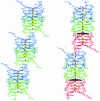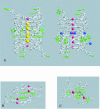A thymine tetrad in d(TGGGGT) quadruplexes stabilized with Tl+/Na+ ions
- PMID: 14960719
- PMCID: PMC373404
- DOI: 10.1093/nar/gkh269
A thymine tetrad in d(TGGGGT) quadruplexes stabilized with Tl+/Na+ ions
Abstract
We report two new structures of the quadruplex d(TGGGGT)4 obtained by single crystal X-ray diffraction. In one of them a thymine tetrad is found. Thus the yeast telomere sequences d(TG1-3) might be able to form continuous quadruplex structures, involving both guanine and thymine tetrads. Our study also shows substantial differences in the arrangement of thymines when compared with previous studies. We find five different types of organization: (i) groove binding with hydrogen bonds to guanines from a neighbour quadruplex; (ii) partially ordered groove binding, without any hydrogen bond; (iii) stacked thymine triads, formed at the 3'ends of the quadruplexes; (iv) a thymine tetrad between two guanine tetrads. Thymines are stabilized in pairs by single hydrogen bonds. A central sodium ion interacts with two thymines and contributes to the tetrad structure. (v) Completely disordered thymines which do not show any clear location in the crystal. The tetrads are stabilized by either Na+ or Tl+ ions. We show that by using MAD methods, Tl+ can be unambiguously located and distinguished from Na+. We can thus determine the preference for either ion in each ionic site of the structure under the conditions used by us.
Figures




References
-
- Blackburn E.H. (2001) Switching and signalling at the telomere. Cell, 106, 661–673. - PubMed
-
- Phillips K., Dauter,Z., Murchie,A.I.H., Lilley,D.M. and Luisi,B.(1997) The crystal structure of a parallel-stranded guanine tetraplex at 0.95Å resolution. J. Mol. Biol., 273, 171–182. - PubMed
-
- Haider S., Parkinson,G.N. and Neidle,S. (2002) Crystal structure of the potassium form of an Oxytricha nova G-quadruplex. J. Mol. Biol., 320, 189–200. - PubMed
-
- Parkinson G.N., Lee,M.P.H. and Neidle,S. (2002) Crystal structure of parallel quadruplexes from human telomeric DNA. Nature, 417, 876–880. - PubMed
-
- Guschlbauer W., Chantot,J.-F. and Thiele,D.(1990) Four-stranded nucleic acid structures 25 years later: from guanosine gels to telomere DNA. J. Biomol. Struct. Dyn., 8, 491–511. - PubMed
Publication types
MeSH terms
Substances
LinkOut - more resources
Full Text Sources
Other Literature Sources

